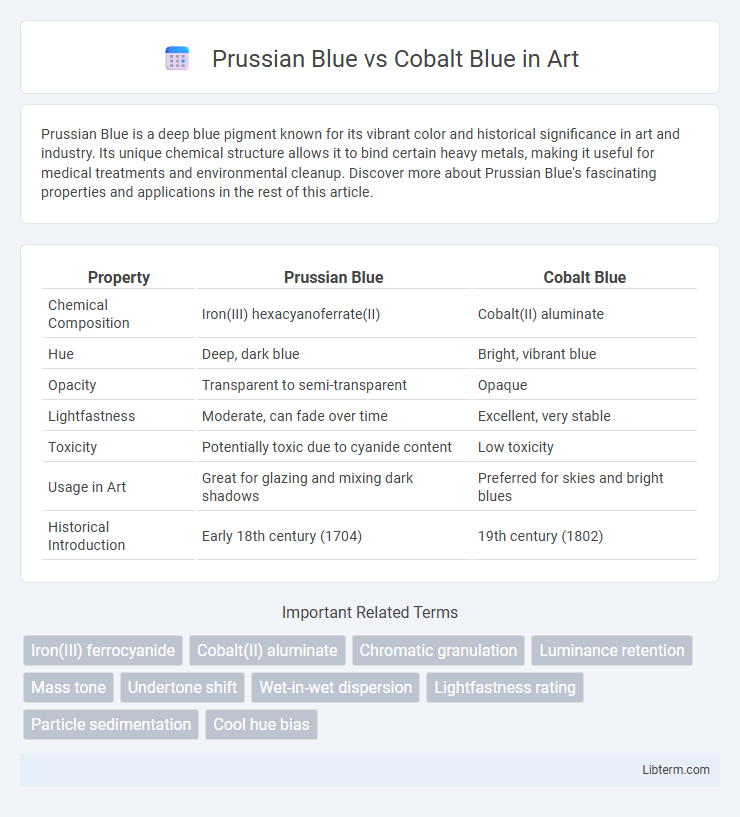Prussian Blue is a deep blue pigment known for its vibrant color and historical significance in art and industry. Its unique chemical structure allows it to bind certain heavy metals, making it useful for medical treatments and environmental cleanup. Discover more about Prussian Blue's fascinating properties and applications in the rest of this article.
Table of Comparison
| Property | Prussian Blue | Cobalt Blue |
|---|---|---|
| Chemical Composition | Iron(III) hexacyanoferrate(II) | Cobalt(II) aluminate |
| Hue | Deep, dark blue | Bright, vibrant blue |
| Opacity | Transparent to semi-transparent | Opaque |
| Lightfastness | Moderate, can fade over time | Excellent, very stable |
| Toxicity | Potentially toxic due to cyanide content | Low toxicity |
| Usage in Art | Great for glazing and mixing dark shadows | Preferred for skies and bright blues |
| Historical Introduction | Early 18th century (1704) | 19th century (1802) |
Introduction: Prussian Blue vs Cobalt Blue
Prussian Blue and Cobalt Blue are two vibrant pigments widely used in art and industry, each valued for its unique hue and chemical properties. Prussian Blue, known for its deep, intense blue color, is a complex iron cyanide compound with excellent staining and lightfastness characteristics. Cobalt Blue, a cobalt aluminum oxide pigment, offers a bright, slightly greenish blue shade prized for its stability, opacity, and resistance to high temperatures.
Historical Origins of Prussian Blue and Cobalt Blue
Prussian Blue, discovered in the early 18th century in Berlin, is the first synthetic pigment and revolutionized the art world with its intense blue hue derived from iron cyanide complexes. Cobalt Blue, identified in the early 19th century by Thenard, is a stable, vibrant pigment created using cobalt salts and alumina, favored for its durability and resistance to fading. Both pigments played critical roles in painting history, with Prussian Blue marking the advent of synthetic colors and Cobalt Blue enhancing pigment longevity and colorfastness.
Chemical Composition and Pigment Properties
Prussian Blue, chemically known as Iron(III) ferrocyanide (Fe7(CN)18*xH2O), is a deep blue pigment characterized by high tinting strength, excellent lightfastness, and unique blue tones with greenish undertones. Cobalt Blue, primarily composed of cobalt(II) aluminate (CoAl2O4), exhibits a brilliant, intense blue hue with exceptional opacity, superior weather resistance, and remarkable chemical stability. The distinctly different chemical structures influence their pigment properties, with Prussian Blue favored for its vibrant, transparent washes in art, while Cobalt Blue is preferred for opaque applications requiring durability.
Color Appearance and Visual Differences
Prussian Blue exhibits a deep, rich, and intense blue with a slightly greenish undertone, creating a darker, more muted tone compared to the brighter and lighter cobalt blue. Cobalt Blue appears vibrant, clear, and pure with a slightly reddish tint, offering high opacity and excellent color retention in artistic applications. Visually, Prussian Blue is preferred for creating shadows and depth due to its deep hue, while Cobalt Blue is favored for skies and water because of its bright and luminous quality.
Lightfastness and Durability Comparison
Prussian Blue exhibits excellent lightfastness with strong resistance to fading over time, making it highly durable in various artistic applications. Cobalt Blue also offers superior lightfastness, maintaining color integrity under prolonged exposure to light, though it tends to be more chemically stable and less prone to discoloration. Both pigments are favored for durability, but Prussian Blue's fast-drying nature and higher sensitivity to alkalis slightly impact its longevity compared to the more robust and weather-resistant Cobalt Blue.
Mixing Qualities in Art and Painting
Prussian Blue offers deep, intense tones with strong tinting strength, making it ideal for mixing rich, dark shadows and vibrant greens when combined with yellows. Cobalt Blue provides a lighter, more muted hue with moderate opacity, allowing for subtle tints and smoother transitions in pastel blends. Artists often choose Prussian Blue for dramatic contrasts, while Cobalt Blue excels in delicate layering and glazing techniques.
Common Artistic Uses and Applications
Prussian Blue offers deep, intense hues ideal for painting skies, waterscapes, and shadows, making it a favorite for landscape and seascape artists. Cobalt Blue provides a lighter, more opaque tone favored in glazing, underpainting, and creating vibrant accents in portrait and still life artworks. Both pigments are valued for their excellent lightfastness and mixing qualities, enhancing color depth and vibrancy in various acrylic, oil, and watercolor applications.
Safety and Toxicity Considerations
Prussian Blue is considered safer with low toxicity and is commonly used as a medication to treat certain types of heavy metal poisoning. Cobalt Blue contains cobalt compounds that may pose health risks if inhaled or ingested in significant amounts, leading to potential respiratory or skin sensitization issues. Proper handling, protective equipment, and ventilation are essential when working with Cobalt Blue pigments to minimize exposure and toxicity.
Availability and Price Factors
Prussian Blue is widely available and generally more affordable due to its long history and common use in traditional artworks and industrial applications. Cobalt Blue, known for its vibrant hue and superior lightfastness, tends to be more expensive and less readily available because of the complex extraction and manufacturing processes from cobalt ores. The price disparity largely reflects the rarity of raw materials and the intensity of production techniques required for Cobalt Blue compared to the synthetic synthesis of Prussian Blue.
Choosing the Right Blue: Which One to Use?
Prussian Blue offers a deep, intense hue with strong tinting strength, ideal for creating rich shadows and cool tones in paintings, while Cobalt Blue provides a lighter, more opaque color with excellent lightfastness, perfect for skies and delicate highlights. Artists should choose Prussian Blue for dramatic depth and vibrant contrast, whereas Cobalt Blue suits soft, airy compositions needing subtle blending and durability. Understanding these distinct pigment properties ensures selecting the right blue enhances the artwork's visual impact and longevity.
Prussian Blue Infographic

 libterm.com
libterm.com